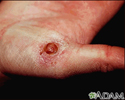Pyogenic granuloma
Lobular capillary hemangioma
Pyogenic granulomas are small, raised, and red bumps on the skin. The bumps have a smooth surface and may be moist. They bleed easily because of the high number of blood vessels at the site. It is a benign (noncancerous) growth.
Causes
The exact cause of pyogenic granulomas is unknown. They often appear following an injury on the hands, arms, or face.
Pyogenic granulomas are common in children.
Symptoms
Signs of a pyrogenic granuloma are:
- A small red lump on the skin that bleeds easily
- Often found at the site of a recent injury
- Usually seen on hands, arms, and face, but they may develop in the mouth (most often in pregnant women)
Exams and Tests
Your health care provider will do a physical exam to diagnose this condition.
You may also need a skin biopsy to confirm the diagnosis.
Skin biopsy
A skin lesion biopsy is when a small amount of skin is removed so it can be examined. The skin is tested to look for skin conditions or diseases. A...

Treatment
Small pyogenic granulomas may go away suddenly. Larger bumps are treated with:
Granulomas
Granulomatosis with polyangiitis (GPA) is a rare disorder in which blood vessels become inflamed. This leads to damage in major organs of the body. ...

- Surgical shaving or excision
-
Electrocautery
(heat)
Electrocautery
Electrocauterization is the process of heating tissue with electricity.
Read Article Now Book Mark Article - Freezing
- A laser
- Creams applied to the skin (may not be as effective as surgery)
Outlook (Prognosis)
Most pyogenic granulomas can be removed. A scar may remain after treatment. There is a high chance that the problem will come back if the whole granuloma is not destroyed during treatment.
Possible Complications
These problems may occur:
- Bleeding from the granuloma
- Return of the condition after treatment
When to Contact a Medical Professional
Call your provider if you have a skin bump that bleeds easily or that changes appearance.
References
Habif TP. Vascular tumors and malformations. In: Habif TP, ed. Clinical Dermatology . 6th ed. Philadelphia, PA: Elsevier; 2016:chap 23.
Patterson JW. Vascular tumors. In: Patterson J, ed. Weedon's Skin Pathology . 4th ed. Philadelphia, PA: Elsevier; 2016:chap 38.
-
Pyogenic granuloma - close-up - illustration
Pyogenic granulomas are skin lesions that can develop after an injury. They contain many blood vessels, and tend to bleed easily if bumped. These lesions are raised, red, and moist, and the skin around them may be inflamed.
Pyogenic granuloma - close-up
illustration
-
Pyogenic granuloma on the hand - illustration
Pyogenic granulomas are reactive lesions made-up of blood vessels (vascular) on the skin, seen here on the hand. They are brittle and tend to bleed easily if bumped. They are raised, red, and moist, and the skin around them may be inflamed. These lesions are seen most commonly in children.
Pyogenic granuloma on the hand
illustration
-
Pyogenic granuloma - close-up - illustration
Pyogenic granulomas are skin lesions that can develop after an injury. They contain many blood vessels, and tend to bleed easily if bumped. These lesions are raised, red, and moist, and the skin around them may be inflamed.
Pyogenic granuloma - close-up
illustration
-
Pyogenic granuloma on the hand - illustration
Pyogenic granulomas are reactive lesions made-up of blood vessels (vascular) on the skin, seen here on the hand. They are brittle and tend to bleed easily if bumped. They are raised, red, and moist, and the skin around them may be inflamed. These lesions are seen most commonly in children.
Pyogenic granuloma on the hand
illustration
Review Date: 10/31/2016
Reviewed By: Kevin Berman, MD, PhD, Atlanta Center for Dermatologic Disease, Atlanta, GA. Review provided by VeriMed Healthcare Network. Also reviewed by David Zieve, MD, MHA, Isla Ogilvie, PhD, and the A.D.A.M. Editorial team.


